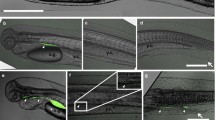Abstract
DURING current investigations into the laboratory conditions necessary for consistently successful marine fish-rearing, it has become increasingly evident that the osmotic hazard confronting the early larva is much greater than that facing the adult. Both larva and adult live under an osmotic strain, having internal salt concentrations roughly one-third that of the surrounding sea water.
Similar content being viewed by others
References
Meek, A., Fish. Invest., Lond., 7, No. 1 (1924).
Shelbourne, J. E., J. Mar. Biol. Assoc. U.K., 35, 275 (1956).
Smith, H. W., Amer. J. Physiol., 93, 480 (1930).
Keys, A. B., and Willmer, E. N., J. Physiol., 76, 368 (1932).
Copeland, D. E., J. Morph., 82, 201 (1948).
Lison, L., “Histochemie animale; méthodes et problèmes” (Paris, 1936).
Author information
Authors and Affiliations
Rights and permissions
About this article
Cite this article
SHELBOURNE, J. Site of Chloride Regulation in Marine Fish Larvæ. Nature 180, 920–922 (1957). https://doi.org/10.1038/180920a0
Issue Date:
DOI: https://doi.org/10.1038/180920a0
- Springer Nature Limited
This article is cited by
-
Ontogenetic changes in cutaneous and branchial ionocytes and morphology in yellowfin tuna (Thunnus albacares) larvae
Journal of Comparative Physiology B (2019)
-
Ontogenic change of gill chloride cells in leptocephalus and glass eel stages of the Japanese eel, Anguilla japonica
Marine Biology (2007)
-
Salinity tolerance in diapausing embryos of the annual killifish Austrofundulus limnaeus is supported by exceptionally low water and ion permeability
Journal of Comparative Physiology B (2007)
-
Salinity effects on development of chloride cells in the larvae of ayu (Plecoglossus altivelis)
Marine Biology (1990)
-
Drinking activity of the newly hatched larvae of codGadus morhua L.
Fish Physiology and Biochemistry (1987)





